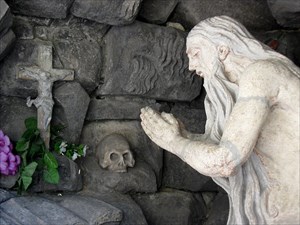(Описание на русском - ниже)

The first church here was built at the time of the Galitsko-Volynskoye princedom. The cathedral (as we see it at present) was constructed in 1744-1770. The author of the project was Bernard Meretin (in some sources it is wrongly named Bogdan) who was the chief court architect of the Polish king August III (at that thime Lvov was a part of Poland). Meretin died before his construction was finished. Klemens Fesinger continued his work. The magnificent baroque cathedral was completely furnished by 1762. Remarkable figures at the front of the building were made by the other well-known master, Johann Pinzel. In modern Lvov there's the museum of Pinzel's works (in the former monastery of Carmelites which is not too far from the Monastery of St.Bernard). The bell on the cathedral belltower is the most ancient bell in Ukraine (1341).
The history of this fine temple has been uneasy. Orthodox sources underline that it the orthodox church to build first churches in Lvov (during the time of Prince Lev) and that there was an orthodox church at this place too. The cathedral of St.Jura initially operated as Uniat (after the well-known agreement between the Ukrainian catholics and Rome). After WW2 in 1946 the Soviet government initiated repressions against the Ukrainian Catholic Church. The cathedral was transferred to the Russian Orthodox Church. About 1990 catholics were sentenced and sent to prisons/camps. Only in 1990 after a meeting of president Gorbachev and Pope John Pavel II Greek-Catholics returned their legal status - and the cathedral of St. Jura. Till 2005 it there was a residence of the head of church, and later the residence moved to Kiev.

Today the cathedral is open to the public (except some premises) and many tourists visit this interesting place. Take a look at the figure under the front ladder. This sculptural composition represents praying St. Onufrij. At the facade of the building you can see St. Athanasius and St. Lev, works by Johann Pinzel.
The temple of St. Jura is undoubtedly a must see while spending at least a couple of days sightseeing in Lvov.
The cache is magnetic micro. Please don't attract anyones attention and bring a pen or a pencil with you. For a hint have a look at the enclosed image.
(For description in English look above)
Создавать тайник у собора Св.Юра во Львове – все равно, что "отайничивать", скажем, Софийский собор в Киеве. Все знают, где это. Гигантское количество информации и фотографий в интернете. Всякий турист, приезжающий в город, считает своим долгом... ну, вы поняли.
Поэтому – просто несколько слов об истории. И – почему Св.Юра надо посетить, если вы оказались во Львове.
Первая церковь на этом месте возникла во времена Галицко-Волынского княжества. Нынешний собор был построен в 1744-1770 годах по проекту Бернарда Меретина (в некоторых источниках ошибочно назван Богданом), незаурядного специалиста и придворного архитектора польского короля Августа III (Львов тогда входил в состав Польши). Меретин не дожил до окончания работ в соборе, дело продолжал Клеменс Фесингер (отделка собора полностью завершена лишь к 1762 году). Затейливые фигуры на фасаде здания принадлежат другому знаменитому мастеру – Иоганну Пинзелю. Ныне во Львове действует музей работ Пинзеля в бывшем монастыре кармелиток, что за бернардинским собором. Говорят, что на колокольне собора размещен самый древний в Украине колокол (1341 г.).
Историческая "конфессиональная" судьба этого прекрасного храма непроста. Православные источники подчеркивают, что первыми религиозными постройками на Святоюрской горе были именно православные церкви – начиная с времен князя Льва. А вот собор Св.Юра изначально строился как греко-католический. Те же источники называют его "униатским", как и всю церковь – из-за унии между Украинской греко-католической церковью (УКГЦ) и Римом. После войны в 1946 году советская власть начала ликвидацию УКГЦ, и собор был передан РПЦ. До 1990 года униатов преследовали, отправляли в лагеря и ссылки. Лишь в 1990 году после встречи президента Горбачева и Папы Римского Иоанна Павла II греко-католики вернули себе легальное положение, а с ним и собор Св.Юра. До 2005 года это была резиденция главы церкви, а потом она переместилась в Киев.
Зайти на территорию не возбраняется, суровых охранников или шикающих старушек, столь привычных в нашей стране, я не заметил. Под лестницей обратите внимание на скульптурную композицию, которая изображает молящегося Св.Онуфрия. Над входом в храм – пинзелевские скульптуры святых Афанасия и Льва. При желании можно зайти внутрь и даже фотографировать.
Храм Св.Юры, несомненно, стоит посетить как одну из главных святынь Львова и великолепный образец архитектуры барокко.